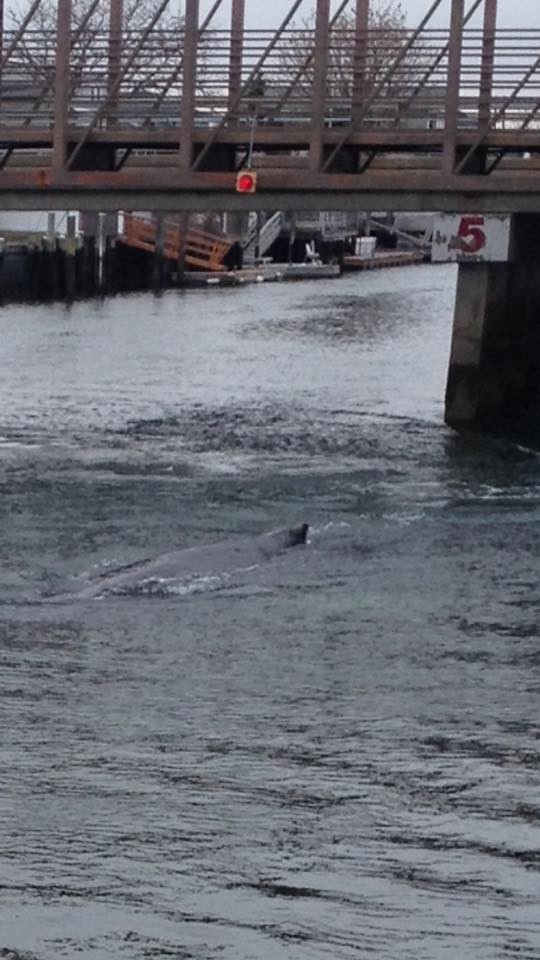A whale of a problem: Environmentalists fear for safety of humpback in Reynolds Channel, offshore
Marine biologists, the U.S. Coast Guard and other agencies are monitoring two separate incidents involving humpback whales over the past several days, including one in which rescuers attempted to remove netting from a whale off Long Beach on Sunday.
Another humpback has been seen in Reynolds Channel, and local environmentalists expressed fear for its safety, especially if it enters shallow water.
Both whales did not appear to be in distress, officials emphasized, but said that the netting on the entangled whale could eventually harm the animal. On Sunday, members of the Center for Coastal Studies’ Marine Animal Entanglement Response team spent the entire day attempting to remove plastic fishing netting from the whale with assistance from the U.S. Coast Guard.
“The whale has actually been in that neighborhood for a while, and we were down there over the weekend trying to work on it,” said Scott Landry, director of Marine Animal Entanglement Response. “The whale is in a really bad situation, but I wouldn’t say it’s in immediate distress. The animal is mostly caught up in rope and it’s a young animal; it’s made of plastic and will grow into the whale and basically open the animal up to infection. We may have had some success, but I think that’s a little too optimistic — basically, the whale is free swimming in the netting.”
Residents took to social media over the weekend after they observed numerous boats off the coast on Sunday. Landry said that in addition to his team, there were hundreds of fishing boats as well as whale-watching vessels out in the area that day.
“The whales were there for the same reason that the fisherman were there, who were probably going after the striped bass,” he said.
Landry said it’s common to see whales in the area this time of year, and explained that at least four or five other whales have been seen feeding in ocean, mostly on bunker fish.
“This is the 40th confirmed case off the East Coast this year,” Landry said of the latest whale to become entangled. “This is a major threat facing whales — and it’s not garbage in the ocean per se; this whale is caught up in the gear we use to catch our food. But don’t assume that the whale became entangled in that neighborhood — it could’ve picked up this gear elsewhere as it travels thousands of kilometers.”
Landry said that members of Gotham Whale, a whale research and advocacy organization, spotted the whale off Long Beach on Nov. 4, and assisted his organization during the rescue effort. He noted the challenges he and his team faced while trying to remove the line from the whale.
“What the recreational boaters was seeing us do on Sunday was chasing a whale who would be submerged for about 10 minutes, and then come up in any direction,” he said, adding that the rope was mostly around the whale’s head. “That’s a super hard place for us to get to because that part of the body doesn’t stay above the waterline for that long. We have to make one simple cut, but it has to be through a tiny rope on its head, and the challenge is to get to that area.”
Landry said that he hopes his team, which is based in Cape Cod, gets another shot to completely free the whale, and said that Whale Watchers would continue to monitor the animal.
“This whale could show up off of Montauk, it could show up off of Sandy Hook,” he said. “Unfortunately, we can’t guess where that whale is going to be at any given time.”
The first reports of the whale in Reynolds Channel, meanwhile, began appearing on social media on Nov. 9 according to Rachel Bosworth, a spokeswoman for the Atlantic Marine Conservation Society.
She said that while whale sightings off the southern coast of the barrier island were common, ones inside Reynolds Channel were rare, and that as of Nov. 15, a marine biologist from her organization was on site gathering information.
“Right now we’re just monitoring this whale and the situation to see what’s going on,” Bosworth said, also adding that the whale did not appear to be in distress.
She urged the public to report sightings, but also to keep their distance both for residents’ and the whale’s safety. Members of the Town of Hempstead Bay Constables and the Coast Guard were also monitoring the situation.
Long Beach resident Scott Bochner, a local environmentalist who sits on the city’s Environmental Advisory Board and a co-founder of the Sludge Stoppers Task Force, said that he had never before seen a humpback enter the bay, and that there was some concern that it could become stranded.
“It’s crazy to see — its been spouting up and it’s not small,” Bochner said. “It’s shallow when the tide gets low, and you don’t want it to get beached up there. “I know the Coast Guard, Bay Constables and biologists are searching for it to somehow coax it out. It looks healthy and doesn’t look like it’s hurt, but you don’t want it to get into shallow water.”









